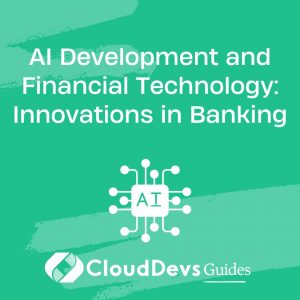AI Development and Financial Technology: Innovations in Banking
In the rapidly evolving landscape of financial technology, or FinTech, the integration of artificial intelligence (AI) has emerged as a game-changer, revolutionizing the way banking services are delivered and consumed. AI’s advanced capabilities in data analysis, pattern recognition, and automation have not only streamlined traditional banking processes but have also paved the way for novel and customer-centric financial solutions. This article delves into the synergies between AI development and FinTech, highlighting innovations that are reshaping the banking industry.

1. The Confluence of AI and FinTech
1.1. Understanding the Power of AI in Banking
Artificial Intelligence has transcended its sci-fi roots to become an indispensable tool in various industries, including banking. In the realm of finance, AI’s ability to process vast amounts of data and derive actionable insights has made it an invaluable asset for decision-making, risk assessment, fraud detection, and customer service enhancement. The marriage of AI and FinTech has unlocked new avenues for creating personalized and efficient banking experiences.
1.2. AI-Powered Chatbots: Enhancing Customer Interaction
One of the most visible applications of AI in banking is the integration of AI-powered chatbots into customer service channels. These chatbots, equipped with natural language processing capabilities, can provide instant responses to customer queries, offer guidance on banking processes, and even assist in financial planning. Let’s take a look at a simple Python code snippet that demonstrates the use of a basic chatbot using the nltk library:
python
import nltk
nltk.download('punkt')
from nltk.chat.util import Chat, reflections
pairs = [
[
r"hello|hi|hey",
["Hello! How can I assist you today?",]
],
[
r"(.*) balance(.*)",
["Your current account balance is $1000.",]
],
[
r"(.*) assistance(.*)",
["Of course! I'm here to help. What do you need assistance with?",]
],
# ... More patterns and responses ...
]
def banking_chatbot():
print("Welcome to the Banking Chatbot! Type 'exit' to end the conversation.")
chatbot = Chat(pairs, reflections)
chatbot.converse()
if __name__ == "__main__":
banking_chatbot()
This chatbot, while basic, showcases the potential for automated customer interactions, enhancing user experience and reducing response time.
2. Innovations Shaping the Future of Banking
2.1. Personalized Financial Recommendations
Traditional banking often follows a one-size-fits-all approach, which may not cater to individual customer needs. AI-driven algorithms, fueled by customer data and behavior analysis, enable banks to offer tailored financial advice and product recommendations. Whether it’s suggesting the most suitable credit card, investment options, or savings plans, these recommendations are based on a deep understanding of the customer’s financial situation and goals.
2.2. Fraud Detection and Prevention
Security remains a top concern in the financial sector. AI’s ability to identify unusual patterns and anomalies in transaction data enables banks to promptly detect and prevent fraudulent activities. Machine learning models learn from historical data to recognize fraudulent behaviors, such as unauthorized transactions or identity theft. By analyzing real-time transactions, AI systems can flag suspicious activities and trigger immediate security measures.
2.3. Credit Scoring and Risk Assessment
AI-powered credit scoring models have redefined the lending landscape. Traditional credit scoring methods often rely on limited factors, leading to biases and excluding individuals with no credit history. AI algorithms consider a broader range of data points, including social media behavior, online transactions, and payment histories, to assess an applicant’s creditworthiness more accurately. This inclusivity benefits both lenders and borrowers, fostering financial inclusion.
2.4. Algorithmic Trading
Financial markets operate at lightning speed, where even a slight delay can result in substantial losses. AI-driven algorithmic trading systems leverage real-time market data and historical trends to execute trades swiftly and strategically. Machine learning algorithms continuously learn from market behavior, adapting trading strategies to changing conditions. These systems can execute complex trading strategies far more efficiently than human traders.
2.5. Virtual Financial Advisors
AI-powered virtual financial advisors provide users with a digital platform for investment guidance and financial planning. These advisors use machine learning to analyze customers’ financial goals, risk tolerance, and market trends. They then offer personalized investment strategies and portfolio recommendations. This technology democratizes financial advisory services, making them accessible to a wider audience.
3. The Impact on Customer Experience
The convergence of AI and FinTech is ultimately aimed at enhancing the overall customer experience. By automating routine tasks, minimizing errors, and providing personalized solutions, AI-driven innovations empower customers to manage their finances with ease. Here’s a look at how AI is transforming the customer experience in banking:
3.1. 24/7 Availability
AI-powered chatbots and virtual assistants are available round the clock, providing instant responses to customer inquiries. This accessibility eliminates the frustration of waiting for business hours and expedites issue resolution.
3.2. Seamless Onboarding
Traditional account opening processes can be lengthy and cumbersome. AI streamlines customer onboarding by automating document verification, reducing manual data entry, and expediting the approval process. This ensures a smoother experience for new customers.
3.3. Hyper-Personalization
AI algorithms analyze transaction histories, spending patterns, and preferences to offer personalized product recommendations and financial insights. Customers feel more valued when their individual needs are understood and catered to.
3.4. Enhanced Security
With the rise of cyber threats, AI-powered security measures provide an extra layer of protection. Behavior analysis, biometric authentication, and anomaly detection contribute to safeguarding customer accounts and sensitive information.
4. Future Prospects and Challenges
While the integration of AI and FinTech holds immense promise, it also brings forth certain challenges that need to be addressed:
4.1. Data Privacy and Ethics
The extensive use of customer data for AI-driven solutions raises concerns about data privacy and ethics. Striking the right balance between utilizing data for personalized services and respecting user privacy is a critical challenge.
4.2. Skill Gap
The implementation and maintenance of AI systems require specialized skills. Financial institutions need to bridge the skill gap by training employees or collaborating with experts to ensure the effective deployment of AI-powered solutions.
4.3. Regulatory Compliance
Financial institutions operate in a heavily regulated environment. Integrating AI solutions must comply with various regulations, including data protection laws and anti-money laundering regulations.
4.4. Bias and Fairness
AI algorithms can inadvertently perpetuate biases present in historical data. Ensuring fairness and eliminating discrimination in AI-driven decisions is a complex task that requires ongoing vigilance.
4.5. Customer Acceptance
While younger generations are more receptive to AI-based banking services, older customers may have reservations about automated interactions. Educating customers about the benefits and security measures of AI is essential for widespread acceptance.
Conclusion
The fusion of AI development and Financial Technology has ushered in a new era of banking innovation. From AI-powered chatbots transforming customer interactions to sophisticated algorithms shaping investment strategies, the potential for enhancing financial services is boundless. As the industry continues to embrace these technological advancements, collaboration between fintech experts, AI researchers, and regulatory bodies will be pivotal in harnessing AI’s transformative power responsibly. The journey towards a more efficient, customer-centric, and secure banking landscape has only just begun, and the path ahead holds exciting possibilities.
Table of Contents









